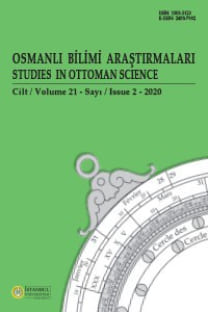Fiziğin Askeri Yürüyüşü-II: Ondokuzuncu Yüzyıl Osmanlı Askeri Okullarının Fizik ve Mekanik Bilimler Öğretmenleri ve Ders Kitapları
Osmanlı İmparatorluğu’nda fiziğin ve mekanik bilimlerin disiplin haline gelme tarihi, yavaş ve birikimsel bir süreç olmuştur. Bu süreç, ondokuzuncu yüzyıl reformlarının gözde kurumları olan modern askeri okulların kuruluşu ve gelişimiyle yakından ilgilidir. Bu makale, Osmanlı askeri okullarından Mühendishane-i Berri-i Hümayun, Mekteb-i Bahriye-i Şahane, Mekteb-i Tıbbiye-i Şahane ve Mekteb-i Harbiye-i Şahane’de ondokuzuncu yüzyılda verilen fizik ve mekanik bilimler eğitimini ele alan bir araştırmanın ürünüdür. Makalenin yazarı, üç eğitimsel öğenin bu dönem fiziğinin meydana gelmesinde temel teşkil ettiğini varsaymaktadır: Ders programı, öğretmen ve ders kitabı. Bu okulların ders programlarında fizik ve mekaniğin yeri daha önce, Fiziğin Askeri Yürüyüşü I adlı makalede ele alınmıştı. Bu makale ise, diğer iki eğitimsel öğeyi, fizik-mekanik bilimler öğretmenlerini ve onların yazdığı ders kitaplarını incelemektedir
Anahtar Kelimeler:
Fizik eğitimi, fizik öğretmenleri, mekanik öğretmenleri, fizik ders kitapları, mekanik ders kitapları, Osmanlı askeri okulları, Osmanlı İmparatorluğu, fizik tarihi, ondokuzuncu yüzyıl
The Military March of Physics – II: Teachers and Textbooks of Physics and Mechanical Sciences of the 19th Century Ottoman Military Schools
Discipline-building history of physics and mechanical sciences in the Ottoman Empire was a slow and accumulative process. It owed much to the establishment and advancement of modern military schools –the favorite institutions of the nineteenth-century reforms. This research article examines the education of physics and mechanical sciences at the Ottoman military schools of the nineteenth-century: the Mühendishane-i Berri-i Hümayun (the Military Engineering School), the Mekteb-i Bahriye-i Şahane (the Naval Academy), the Mekteb-i Tıbbiye-i Şahane (the Military School of Medicine), and the Mekteb-i Harbiye-i Şahane (the Military Academy). The author presupposes three educational elements that were essential in the constitution of physics in this period: The curriculum, the teacher and the textbook. Place of physics and mechanical sciences in the curricula of these schools, has been examined in a previous article, The Military March of Physics I. The present article, on the other hand, examines the other two educational elements: teachers of physics and mechanical sciences, and textbook written by them.
Keywords:
Physics education, physics teachers, mechanics teachers, physics textbooks, mechanics textbooks, Ottoman military schools, the Ottoman Empire, history of physics, the nineteenth-century,
___
- -
- ISSN: 1303-3123
- Yayın Aralığı: Yılda 2 Sayı
- Başlangıç: 1995
- Yayıncı: İstanbul Üniversitesi Edebiyat Fakültesi
Sayıdaki Diğer Makaleler
A.Adıvar'ın MV İslam Ansiklopedisi'ne yazdığı 'Mukaddime'nin çevirmenleri hakkında
Anadolu’nun dar bir yöresinden örnek toplamış bitki toplayıcıları
Ord.Prof.Dr. Wolfgang Gleissberg’in Türk Astronomi Derneği Başkanlığı
Dr. Zigardelakizade Salih Nabi: Psikiyatri ve Müzik
Friederike Sorger’in (1914–2001) Anadolu Gezileri ve Bitki Koleksiyonu
ORD.PROF.DR. WOLFGANG GLEISSBERG'İN TÜRK ASTRONOMİ DERNEĞİ BAŞKANLIĞI
Mecmua-i Fünûn-i Baytariye: İnceleme ve Özetli Bibliyografya
Berfin MELİKOĞLU GÖLCÜ, Şule OSMANAĞAOĞLU SANAL
FRIEDERIKE SORGER'İN (1914-2001) ANADOLU GEZİLERİ VE BİTKİ KOLEKSİYONU
